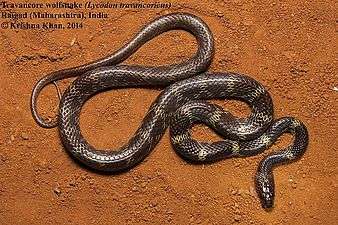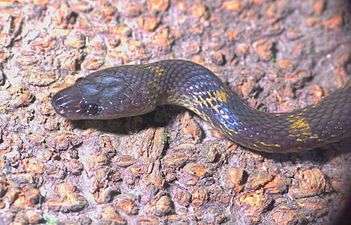Lycodon travancoricus
Lycodon travancoricus, commonly known as the Travancore wolf snake, is a species of colubrid snake endemic to Peninsular India.
| Lycodon travancoricus | |
|---|---|
 | |
| Scientific classification | |
| Kingdom: | Animalia |
| Phylum: | Chordata |
| Class: | Reptilia |
| Order: | Squamata |
| Suborder: | Serpentes |
| Family: | Colubridae |
| Genus: | Lycodon |
| Species: | L. travancoricus |
| Binomial name | |
| Lycodon travancoricus (Beddome, 1870) | |
| Synonyms | |
| |
Description

Lycodon travancoricus is dark brown or black dorsally, with white crossbands and white lineolations on the sides. Ventrally it is uniform white. It is very similar to Lycodon striatus, but the upper lip is brown, or white spotted with brown.
The dorsal scales are smooth, in 17 rows. The ventrals number 175-202; the anal is entire; and the subcaudals are 56-76, usually double, but sometimes single.
Adults may attain 60 cm (23½ inches) in total length, with a tail 12.5 cm (4⅞ inches) long Maximum 742mm (29 in).[2]
Geographic range
It is endemic to Peninsular India. It is a hill-dwelling species, preferring high-elevation wet forests. It occurs in the Western Ghats and Eastern Ghats across Kerala, Tamil Nadu, Karnataka, Goa, Andhra Pradesh, Madhya Pradesh, southern Gujarat and Odisha),[3] and also in isolated localities in Kerala and Maharashtra.[4]
Habits and Habitat
It is a nocturnal snake. It prefers forests, both evergreen and deciduous, on windward plains and hills.[5]
References
- The Reptile Database. www.reptile-database.com.
- Boulenger, G.A. 1893. Catalogue of the Snakes in the British Museum (Natural History), Volume I., Containing the Families...Colubridæ... Trustees of the British Museum (Natural History). London. p. 355 & Plate XXIV., figure 3.
- The Reptile Database. www.reptile-database.org.
- Das, Indraneil. 2002. A Photographic Guide to Snakes and other Reptiles of India. Ralph Curtis Books. Sanibel Island, Florida. 144 pp. (Lycodon travancoricus, p. 39)
- Das, 2002, p. 39.
Further reading
- Beddome, R. H. 1870 Descriptions of new reptiles from the Madras Presidency. Madras Monthly J. Med. Sci., 2: 169-176 [Reprint.: J. Soc. Bibliogr. Nat. Sci., London, 1 (10): 327-334, 1940]
- Chandramouli, S. R. and S. R. Ganesh 2010. Herpetofauna of southern Western Ghats, India – Reinvestigated after decades. Taprobanica 2 (2): 72-85 - get paper here
- Constable, JOHN D. 1949. Reptiles from the Indian Peninsula in the Museum of Comparative Zoology. Bull. Mus. Comp. Zool. Harvard 103: 59-160. - get paper here
- Ganesh S. R., Asokan J. R. 2010. Catalogue of Indian herpetological specimens in the collection of the Government Museum Chennai, India. Hamadryad 35 (1): 46 – 63
- Ganesh, S. R., S. R. Chadramouli, R. Sreekar and P. Gowri Shankar 2013. Reptiles of the central Western Ghats, India — A reappraisal and revised checklist, with emphasis on the Agumbe Plateau. Russ. J. Herpetol. 20 (3): 181-189 - get paper here
- Ganesh, S. R.; M. Arumugam 2016. Species Richness of Montane Herpetofauna of Southern Eastern Ghats, India: A Historical Resume and a Descriptive Checklist Russ. J. Herpetol. 23 (1): 7-24
- Ganesh, S. R.; Subramanian Bhupathy, Patrick David, N. Sathishkumar, G. Srinivas 2014. Snake Fauna of High Wavy Mountains, Western Ghats, India: Species Richness, Status, and Distribution Pattern. Russ. J. Herpetol. 21 (1): 53-64
- Inger, Robert F.;Shaffer, H. Bradley;Koshy, Mammen;Bakde, Ramesh 1984. "A report on a collection of amphibians and reptiles from the Ponmudi, Kerala, South India." J. Bombay Nat. Hist. Soc. 81 (3): 551-570.
- Smith, M.A. 1943. The Fauna of British India, Ceylon and Burma, Including the Whole of the Indo-Chinese Sub-Region. Reptilia and Amphibia. 3 (Serpentes). Taylor and Francis, London. 583 pp.
- Wall, F. 1905. "Notes on Snakes collected in Cannanore from 5th November 1903 to 5th August 1904". J. Bombay Nat. Hist. Soc. 16: 292.
- Wall,F. 1919. "Notes on a collection of Snakes made in the Nilgiri Hills and the adjacent Wynaad." J. Bombay Nat. Hist. Soc. 26: 552-584.
- Whitaker, Romulus and Ashok Captain 2004. Snakes of India. Draco Books, 500 pp.